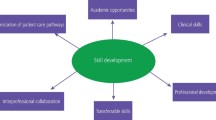Abstract
Background Different skill-mix models have changed the face of the dental workforce. This study aimed to assess how this skill-mix translates into different practice models of care and the employer-dentists' perception of the dental team.
Methods Twenty-two oral health therapists (OHTs) and 12 employer-dentists from both the private and public sectors participated in the online surveys. The OHT survey contained questions on practice models of care and work design characteristics. An open-ended question was added to the dentist survey assessing their perceptions of the OHTs in practice.
Results OHTs provided over 90% of initial point-of-care for children and 40% for adults. All OHTs in the public sector and over 90% of the OHTs in private practice thought their job gave them a high degree of decision-making autonomy, despite over half of OHTs in private practice working under some level of supervision. Most employer-dentists perceived OHTs as an asset to their practice.
Conclusion The collaborative relationship has translated into different dental practice models of care. Dentists indicated that employing an OHT created efficiencies for their practice and OHTs reported they had a high degree of autonomy in the workplace, especially for the treatment of children. Further studies should be conducted to determine what influences the OHTs to exercise full autonomy. The impact of the changes in the oral health workforce will create adaptations in dental education in the future.
This is a preview of subscription content, access via your institution
Access options
Subscribe to this journal
Receive 24 print issues and online access
$259.00 per year
only $10.79 per issue
Buy this article
- Purchase on Springer Link
- Instant access to full article PDF
Prices may be subject to local taxes which are calculated during checkout




Similar content being viewed by others
Change history
14 August 2020
Author's correction note: Research article Br Dent J 2020; 228: 767-772.When this article was published there were errors in Figures 1 and 2. The correct version of and are presented here:The original article has been corrected.
References
Koppelman J, Singer-Cohen R. A Workforce Strategy for Reducing Oral Health Disparities: Dental Therapists. Am J Public Health 2017; DOI: 10.2105/AJPH.2017.303747.
Ross M K, Ibbetson R J, Turner S. The acceptability of dually-qualified dental hygienist-therapists to general dental practitioners in South-East Scotland. Br Dent J 2007; DOI: 10.1038/bdj.2007.45.
Nash D A, Friedman J W, Mathu-Muju K R et al. A review of the global literature on dental therapists. Community Dent Oral Epidemiol 2014; 42: 1-10.
Satur J G, Dewson B. A History of the Dental and Oral Heath Profession in Australia and New Zealand. Aust N Zealand J Dent Oral Health Ther 2012; 1: 13.
Bullock A, Firmstone V. A professional challenge: the development of skill-mix in UK primary care dentistry. Health Serv Manage Res 2011; 24: 190-195.
Sun N, Harris R V. Models of practice organisation using dental therapists: English case studies. Br Dent J 2011; DOI: 10.1038/sj.bdj.2011.624.
Gallagher J E, Kleinman E R, Harper P R. Modelling workforce skill-mix: how can dental professionals meet the needs and demands of older people in England? Br Dent J 2010; DOI: 10.1038/sj.bdj.2010.106.
Lamster I B, Eaves K. A model for dental practice in the 21st century. Am J Public Health 2011; 101: 1825-1830.
Macey R, Glenny A, Walsh T et al. The efficacy of screening for common dental diseases by hygiene-therapists: a diagnostic test accuracy study. J Dent Res 2015; DOI: 10.1177/0022034514567335.
Cannell P. Skill mix - a paradigm shift? Br Dent J 2016; 220: 307.
Dental Board of Australia. Registrant data - Reporting period: 01 July 2019 to 30 September 2019. 2019. Available online at https://www.dentalboard.gov.au/AbouttheBoard/Statistics.aspx (accessed February 2019).
Satur J, Gussy M, Mariño R, Martini T. Patterns of Dental Therapists' Scope of Practice and Employment in Victoria, Australia. J Dent Educ 2009; 73: 416-425.
Gallagher J E, Lim Z, Harper P R. Workforce skill mix: modelling the potential for dental therapists in state-funded primary dental care. Int Dent J 2013; 63: 57-64.
Cowpe J, Barnes E, Bullock A. Skill-mix in dental teams in Wales. Vital 2013; 10: 38-43.
Australian Dental Association. Structured Professional Relationships. 2015. Available at https://www.ada.org.au/News-Media/News-and-Release/Latest-News/Structured-Professional-Relationships (accessed April 2020).
Dental Board of Australia. Code of conduct for registered health practitioners. 2014. Available online at https://www.dentalboard.gov.au/Codes-Guidelines/Policies-Codes-Guidelines/Code-of-conduct.aspx (accessed April 2020).
Australian Health Ministers' Conference. National Health Workforce Strategic Framework. 2004. Available at https://www1.health.gov.au/internet/main/publishing.nsf/Content/C66647AAB9871405CA257BF000209A71/$File/national_strategic_health_workforce_framework.pdf (accessed April 2020).
McKinnon M, Luke G, Bresch J, Moss M, Valachovic R W. Emerging Allied Dental Workforce Models: Considerations for Academic Dental Institutions. J Dent Educ 2007; 71: 1476-1491.
Beazoglou T J, Chen L, Lazar V F et al. Expanded function allied dental personnel and dental practice productivity and efficiency. J Dent Educ 2012; 76: 1054-1060.
Harris P A, Taylor R, Thielke R, Payne J, Gonzalez N, Conde J G. Research electronic data capture (REDCap) - a metadata-driven methodology and workflow process for providing translational research informatics support. J Biomed Inform 2009; 42: 377-381.
House S, Havens D. Nurses' and Physicians' Perceptions of Nurse-Physician Collaboration: A Systematic Review. J Nurs Admin 2017; 47: 165-171.
Morgeson F P, Humphrey S E. The Work Design Questionnaire (WDQ): developing and validating a comprehensive measure for assessing job design and the nature of work. J Appl Psychol 2006; 91: 1321-1339.
Douven I. A Bayesian perspective on Likert scales and central tendency. Psychon Bull Rev 2018; 25: 1203-1211.
Balasubramanian M, Teusner D N. Dentists, specialists and allied practitioners in Australia: Dental Labour Force Collection, 2006. 2011. Available online at https://www.aihw.gov.au/reports/dental-oral-health/dental-labour-force-collection-2006 (accessed April 2020).
Guay A H, Lazar V. Increasing productivity in dental practice: the role of ancillary personnel. J Am Coll Dent 2012; 79: 11-17.
Darling B G, Kanellis M J, McKernan S C, Damiano P C. Potential utilization of expanded function dental auxiliaries to place restoratives. J Public Health Dent 2015; 75: 163-168.
Lazar V F, Guay A H, Beazoglou T J. Economic Impact of Dental Hygienists on Solo Dental Practices. J Dent Educ 2012; 76: 1045-1053.
Thierer T E, Meyerowitz C. Trends in Generalist and Speciality Advanced Dental Education and Practice, 2005-06 to 2015-16 and Beyond. J Dent Educ 2017; DOI: 10.21815/JDE.017.023.
Balasubramanian M, Brennan D S, Short S D, Gallagher J E. A strife of interests: A qualitative study on the challenges facing oral health workforce policy and planning. Health Policy 2019; 123: 1068-1075.
Weintraub J A. What Should Oral Health Professionals Know in 2040: Executive Summary. J Dent Educ 2017; 81: 1024-1032.
Acknowledgements
The authors would like to thank Dr Marc Tennant, Winthrop Professor, Faculty of Science, School of Human Sciences, The University of Western Australia, Perth, Australia, for his support and expert opinion on this topic.
Author information
Authors and Affiliations
Corresponding author
Ethics declarations
The authors report no conflict of interest.
Rights and permissions
About this article
Cite this article
Wong, G., Irving, M. The changing face of dental practice: emerging models of team care in Australia. Br Dent J 228, 767–772 (2020). https://doi.org/10.1038/s41415-020-1529-3
Published:
Issue Date:
DOI: https://doi.org/10.1038/s41415-020-1529-3



